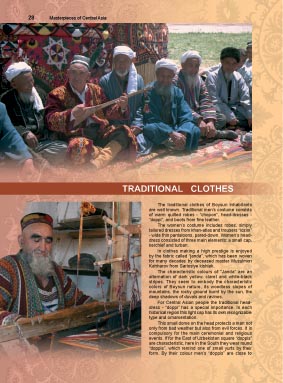The traditional clothes of Boysun inhabitants are well known. Traditional men’s costume consists of warm quilted robes – “chopon”, head-dresses – “doppi”, and boots from fine leather. The women’s costume includes robes, simply tailored dresses from khan-atlas and trousers “lozim” – wide thin pantaloons, pared-down. Women’s head-dress consisted of three main elements: a small cap, kerchief and turban. In clothes making a high prestige is enjoyed by the fabric called “janda”, which has been woven for many decades by deceased master Musulmon Kahharov from Sariosiye kishlak. The characteristic colours of “Janda” are an alternation of dark yellow, claret and white-black stripes. They seem to embody the characteristic colors of Boysun nature, its woodless slopes of mountains, the rocky ground burnt by the sun, the deep shadows of duvals and ravines.
![]()
Главная страница.
Статьи и доклады
Электронная библиотека
Космограммы Центральной Азии
Samarkand
(каталог на англ.яз.)
Boysun
(каталог на англ.яз.)
![]()
![]()
Boysun. Masterpieces of Central Asia
For Central Asian people the traditional head-dress – “doppi” has a special importance. In each historical region this light cap has its own recognizable type and ornamentation. This small dome on the head protects a man not only from bad weather but also from evil forces. It is compulsory for the main ceremonial and religious events. If for the East of Uzbekistan square “doppis” are characteristic, here in the South they wear round “doppis”, which remind one of small yurts by their form. By their colour men’s “doppis” are close to suzane and are embroidered with bright red, yellow, blue and green threads. Their ornamentation evokes the multicolored Boysun hills. Women’s “doppis” of Boysun are more strict and laconic. Their patterns are made by small beads and embroidery with golden threads. Both of them, like the encapsulated cosmic circles of suzane, represent one more model of the ideal world. Across the outer lines of embroidery passes the “oba” stripe that designates its borders. This creates a strong sign of kindness that protects a man.

